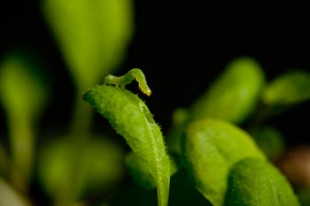PNAS names Rice study one of six best of 2012
A February 2012 Rice study that found plants use circadian rhythm to regulate defenses against insects has been chosen one of the six best papers published in the Proceedings of the National Academy of Sciences (PNAS) in 2012.
Rice’s paper, “Arabidopsis synchronizes jasmonate-mediated defense with insect circadian behavior,” and five others were awarded the 2012 Cozzarelli Prize, which recognizes scientific excellence and originality in each of the six broadly defined classes under which the National Academy of Sciences (NAS) is organized.

From left, Rice University biologists Janet Braam, Danielle Goodspeed and Wassim Chehab, worked with colleagues to show that plants use circadian rhythms to both anticipate raids by hungry insects and to time the production of defensive hormones that fend off such attacks. CREDIT: Jeff Fitlow/Rice University
The study, which was featured in a Rice News article and video, was co-authored by Janet Braam, professor and chair of Rice’s Department of Biochemistry and Cell Biology; lead author Danielle Goodspeed, graduate student in biochemistry and cell biology; Wassim Chehab, faculty fellow in biochemistry and cell biology; former undergraduate Amelia Min-Venditti, who graduated from Rice in 2011; and former Rice faculty member Michael Covington, now at the University of California, Davis.
“It is quite an unusual and impressive honor to be selected as one of the best papers in PNAS, an elite journal with broad readership in the sciences,” said Dan Carson, dean of Rice’s Wiess School of Natural Sciences. “We’re quite proud of this achievement by Dr. Braam and her colleagues.”
The 2012 Cozzarelli winners were chosen from more than 3,700 research articles that appeared in PNAS in 2012. Rice’s paper was chosen as the best paper of the year in the class that covered applied biological, agricultural and environmental sciences.
“The best science is usually a team effort, and this study exemplifies that,” Braam said. “Danielle deserves the lion’s share of credit because this work resulted from her elegant experimental design and dedication to troubleshooting the experiments. Mike posed the original question based on his previous work, and Wassim provided critical insight into the underlying mechanism. The collaborative aspects of the work cannot be overstated; this was only possible because of the critical contributions of each co-author.”
In the study, Braam and her co-authors showed that plants use an “internal clock,” which follows the Earth’s day-night rhythms, to both anticipate daytime raids by hungry insects and make preparations to fend them off.
Goodspeed designed a clever experiment to test whether plants time their anti-insect defense, which typically includes production of chemicals that give insect herbivores an upset stomach. Using 12-hour cycles of light and dark, Goodspeed entrained the circadian clocks of both Arabidopsis plants and cabbage loopers, a type of caterpillar that eats Arabidopsis. Half of the plants were placed with caterpillars on a regular day-night cycle, and the other half were entrained “out of phase” relative to the caterpillars, such that the plants’ internal clocks were set to daytime mode during the hours that the insects were in nighttime mode.
The experiments showed that plants that were in phase with the insects were relatively resistant to being eaten, while out-of-phase plants were decimated. Chehab designed follow-up experiments to understand how the plants used their internal clocks to resist the attacks. The research showed that the plants timed their production of the hormone jasmonate to ramp up just before daybreak to maximize output during the daylight hours when loopers feed.
The 2012 Cozzarelli Prizes will be presented at the PNAS Editorial Board meeting, and awardees will be recognized at a ceremony during the NAS Annual Meeting April 28 in Washington, D.C. The prize is named for late PNAS Editor-in-Chief Nicholas R. Cozzarelli.



Leave a Reply